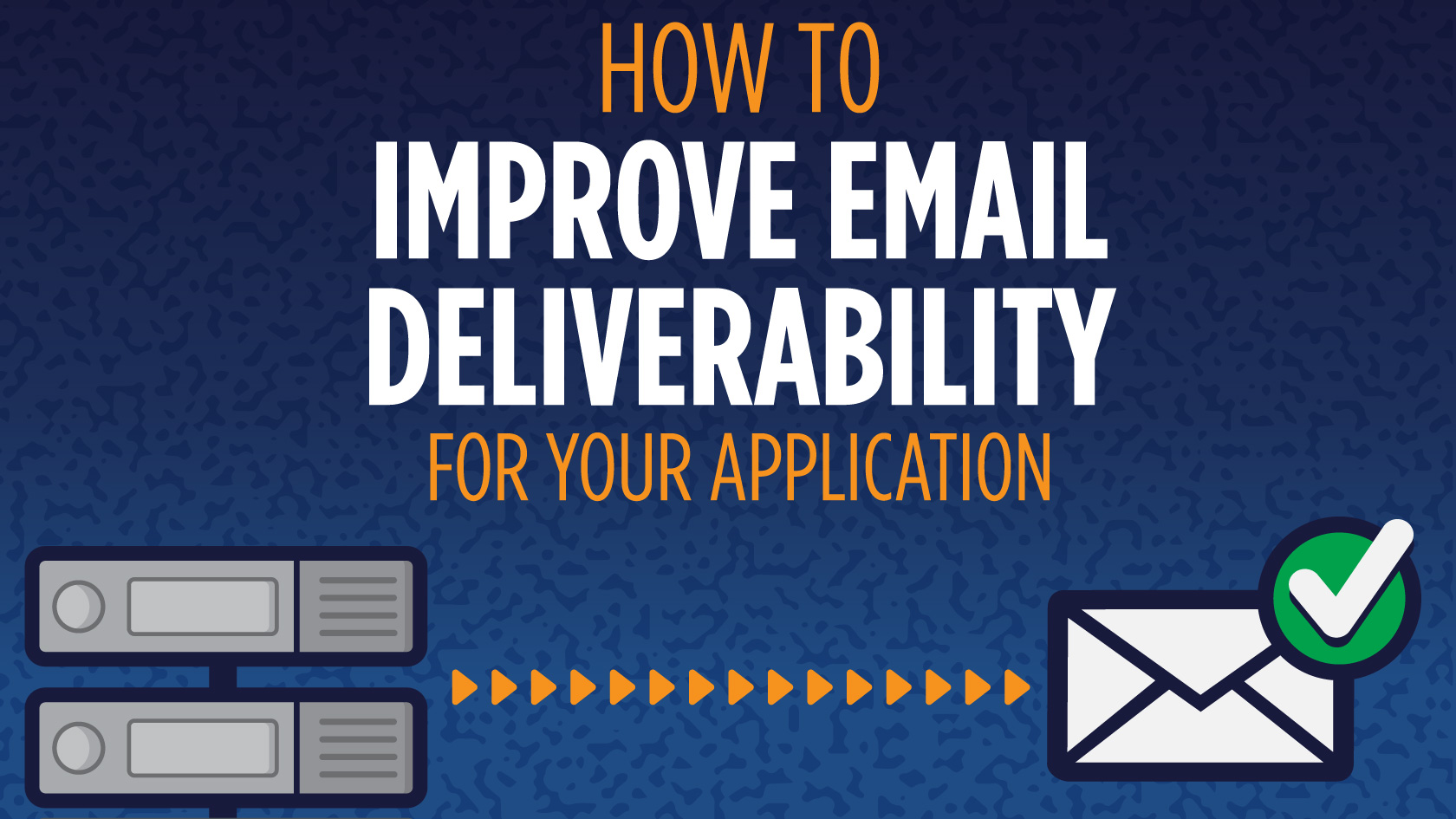What is Email Deliverability?
Email deliverability is the rate at which the emails you send make it successfully to the recipient’s inbox. If you send an email from your application, deliverability can make or break the success of your platform. Whether it’s important password resets, notification emails, order verifications, email receipts or marketing email, a message that never makes it to its destination is a total waste of resources. To get the most out of the email you send, we are going to dive deeper on how to improve email deliverability with seven simple things you can do right now.
Why Emails Don’t Get Delivered
If you’re new to email sending, you’re probably wondering why ‘email deliverability’ is even a topic of discussion. After-all, you hit send and your email goes straight to the recipient, right? The process of sending email can be rather shocking to someone with no experience in the field. In reality, after someone hits send, there are a number of actions happening in the background to get your email to the recipient. When an email is sent, the delivery process looks something like this:
First, the email will go from your application, to the SMTP server. Once the message makes it to the SMTP server, the server connects to the internet to find and communicate with a domain name server (DNS). Think of the DNS as a phone book, providing the server with the information it needs to get to the recipient. The SMTP server and the DNS interact to find the Mail Exchanger (MX) records of the recipient domain. The MX record identifies the mail server that will be accepting the email on behalf of the recipient domain. Once the recipient’s MX records are found, the sending and receiving mail servers connect and communicate to figure out where the message is coming from and where it needs to go. Once this information is established, the recipient server will deliver the message to the recipient’s inbox (if it passes successfully through the mailbox providers spam filters).
Now that you understand more about how an email gets delivered, you can see how there are a lot of moving pieces and plenty of room for error. Multiply this by thousands, or millions of emails sent, and the margin of error only increases. Luckily, SocketLabs has email deliverability down to a science, with seven best practices to follow when you start wondering how you can improve email deliverability from your application.
How to Improve Email Deliverability: 7 Tips
Most of the time when someone is looking to send high volume email, they will enlist the help of an email service provider who has the necessary email delivery platform and professional capabilities to eliminate any worries they might have related to their email infrastructure. With the proper email infrastructure in place, senders can focus on aspects of email they have more control over like authentication, design and copy, list hygiene, delivery methods, and email metrics. Let’s cover some of the specifics on how you can improve your email deliverability today.
1. Get Professional Help Where You Can
As mentioned previously, most developers will look to a professional email service to help send email from their application. Commonly, we will see developers and administrators looking to use our service after trying to build and maintain their own email infrastructure first. As many have found, this work is very strenuous and can lead to lots of setbacks if you don’t know exactly what you are doing. Rather than dealing with the hassle of creating and maintaining your own email infrastructure, many developers will plug SocketLabs email APIs in to their application so they can start sending email right away.
The advantage of using a service like SocketLabs to send email, other than the powerful APIs, comes in the form of:
- A robust email infrastructure that can support over 24,000,000 emails per stream, per day
- A support team that is always ready to help
- Advanced security and encryption capabilities
2. Optimize Email Design and Subject Lines
The way you design your email will keep recipients interested and help build up a good sender reputation. The better your reputation, the more your recipients will be opening your mail down the road. When designing the email that you’ll be sending, it’s important to follow these best practices:
- The email should be mobile friendly and desktop compatible
- The email should be on-brand so people recognize you easily (This includes things like colors, fonts, images, and tone)
- Your email should not consist of only images, have a good image to text ratio
- Avoid spam trigger words (especially in the subject line) such as “toll-free”, “free”, “risk free”, “special offer”, etc.
- If it’s a marketing email, the email must include a valid physical business address and a clear and conspicuous unsubscribe method to stay compliant with the Federal CAN-SPAM Act
- The text in your email should be simple, to-the-point, and easily consumable
- If you are a well known brand that your recipients are comfortable with, promotions and discounts are a good way to get those messages opened
The better your email design and subject-line are, the more positive engagement you will receive, leading to improved deliverability.
3. Maintain Good Email List Hygiene
Any high volume email sender should spend time and effort cleaning their email lists, making sure that the email addresses on it are active. If your emails are continuously bouncing from addresses that are no longer active, then your sender reputation will suffer as a consequence, along with your deliverability.
The good news is that working with SocketLabs gives access to automatic list suppressioning, meaning that any bounced emails will automatically be suppressed so senders don’t have to worry about doing any of this cleaning manually. If you aren’t partnered with an email service provider, you can do this work manually, keeping track of, and removing addresses that are bouncing.
4. Use a Dedicated IP Address For Higher Email Volumes
If you send a lot of email, like over 100,000, it could be a good idea to use a dedicated IP address as opposed to a shared one. While both a dedicated and a shared IP address have their own benefits and setbacks, sending a higher volume of email is better on a dedicated IP if you are looking to maximize your deliverability.
The IP address you send on is monitored by mailbox providers and you are given a universal reputation based on the quality of mail coming from that IP address. A shared IP is great for smaller senders who don’t generate enough mail to build their own sender reputation. However, if you are a larger sender and you send enough mail to build your own reputation, you don’t want the email of other senders to bring your reputation down.
5. Authenticate Your Email
With the increase in malicious actors sending spam or impersonating legitimate senders through email spoofing, certain improvements have been made across the industry to secure email. Senders have the ability to enable email authentication through Sender Policy Framework (SPF) and DomainKeys Identified Mail (DKIM) to help eradicate the act of spoofing and other malicious email tactics.
Enabling these authentication methods helps mailbox providers identify that you are a legitimate sender with an established IP reputation. This will help improve your deliverability by keeping you out of the spam folder and it will also help secure your important email from malicious people.
6. Monitor Your Metrics
One of the best ways to maintain a healthy sender reputation is to monitor your real-time email analytics. Paying close attention to important details like clicks, opens, blocks, failure rates etc. can help avoid any disruptions down-the-road and keep your email program running at optimal performance.
At SocketLabs, we offer a proprietary StreamScore that helps you monitor how the world is reacting to your outbound email. It quantifies the “behind-the-scenes” aspects of your email delivery.
The SocketLabs StreamScore compiles over 20 different metrics to calculate four scores that help you identify:
- The quality of your email lists
- The nature and style of your message content
- The reaction of recipients to your messages
- The degree to which you follow “email best practices”
- The degree to which the combination of content and list quality leads recipients to engage with your content
The more you understand what is happening in the background of your email communication, the better your deliverability will be in the long term.
7. Separate Your Marketing and Transactional Email
As a high volume email sender, it’s important to separate your mail streams by the type of mail you send. Email like password resets, receipts, order confirmations and other transactional email should be sent through one stream, whereas marketing email like promotions, offers and advertisements should be sent on another.
You want to split your mail this way because you don’t want the inherently lessor performance of your marketing mail to ruin the naturally better performance of your transactional mail. If your IP reputation for your marketing mail is less than optimal, your important transactional emails will not suffer the consequences if you divide your mail streams in such a way. To learn more about how separating your mail streams can improve your deliverability, read our full blog on the topic.
Turning Email into Your Most Valuable Asset
If sending high volume email is turning out to be a lot more difficult than you imagined, make sure you do the proper research and choose a perfect email service provider to help fill in the gaps and provide the infrastructure and expertise that you need to succeed.
To learn how SocketLabs can help you for free, visit our plans and pricing page. If you want to dive deeper into email deliverability, read our comprehensive email deliverability guide.









